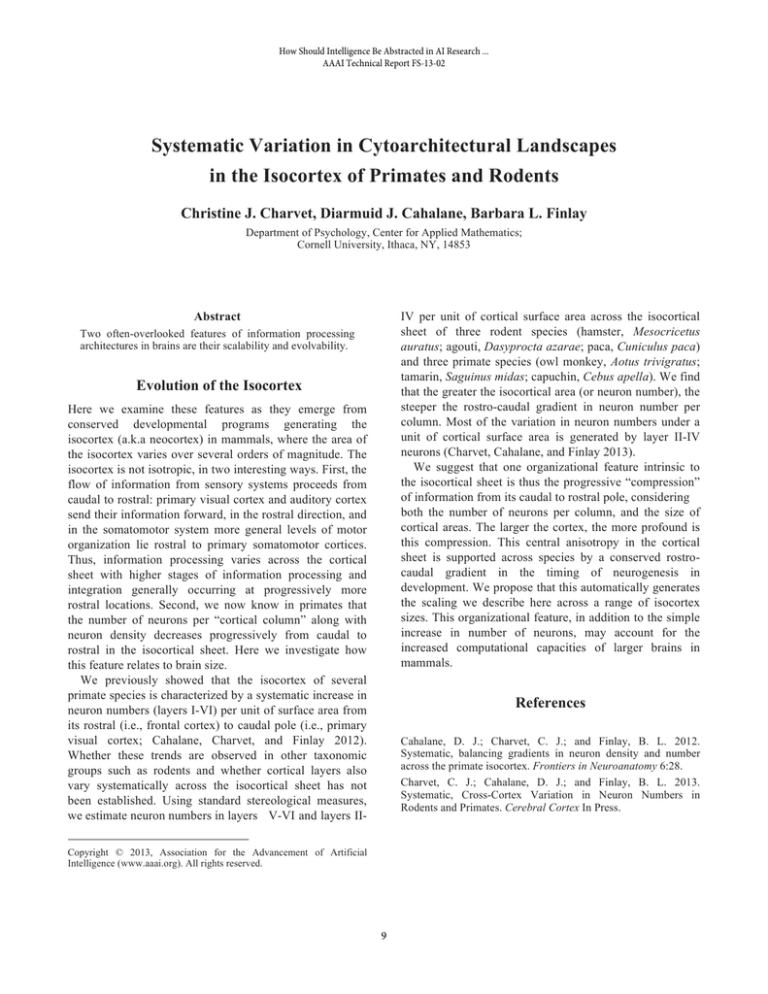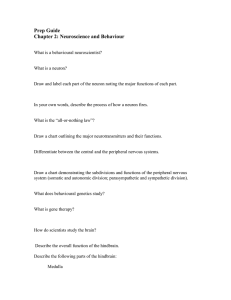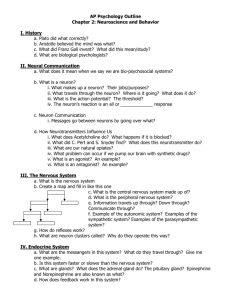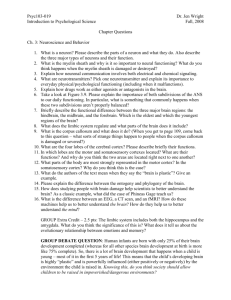
How Should Intelligence Be Abstracted in AI Research ...
AAAI Technical Report FS-13-02
Systematic Variation in Cytoarchitectural Landscapes
in the Isocortex of Primates and Rodents
Christine J. Charvet, Diarmuid J. Cahalane, Barbara L. Finlay
Department of Psychology, Center for Applied Mathematics;
Cornell University, Ithaca, NY, 14853
Abstract
IV per unit of cortical surface area across the isocortical
sheet of three rodent species (hamster, Mesocricetus
auratus; agouti, Dasyprocta azarae; paca, Cuniculus paca)
and three primate species (owl monkey, Aotus trivigratus;
tamarin, Saguinus midas; capuchin, Cebus apella). We find
that the greater the isocortical area (or neuron number), the
steeper the rostro-caudal gradient in neuron number per
column. Most of the variation in neuron numbers under a
unit of cortical surface area is generated by layer II-IV
neurons (Charvet, Cahalane, and Finlay 2013).
We suggest that one organizational feature intrinsic to
the isocortical sheet is thus the progressive “compression”
of information from its caudal to rostral pole, considering
both the number of neurons per column, and the size of
cortical areas. The larger the cortex, the more profound is
this compression. This central anisotropy in the cortical
sheet is supported across species by a conserved rostrocaudal gradient in the timing of neurogenesis in
development. We propose that this automatically generates
the scaling we describe here across a range of isocortex
sizes. This organizational feature, in addition to the simple
increase in number of neurons, may account for the
increased computational capacities of larger brains in
mammals.
Two often-overlooked features of information processing
architectures in brains are their scalability and evolvability.
Evolution of the Isocortex
Here we examine these features as they emerge from
conserved developmental programs generating the
isocortex (a.k.a neocortex) in mammals, where the area of
the isocortex varies over several orders of magnitude. The
isocortex is not isotropic, in two interesting ways. First, the
flow of information from sensory systems proceeds from
caudal to rostral: primary visual cortex and auditory cortex
send their information forward, in the rostral direction, and
in the somatomotor system more general levels of motor
organization lie rostral to primary somatomotor cortices.
Thus, information processing varies across the cortical
sheet with higher stages of information processing and
integration generally occurring at progressively more
rostral locations. Second, we now know in primates that
the number of neurons per “cortical column” along with
neuron density decreases progressively from caudal to
rostral in the isocortical sheet. Here we investigate how
this feature relates to brain size.
We previously showed that the isocortex of several
primate species is characterized by a systematic increase in
neuron numbers (layers I-VI) per unit of surface area from
its rostral (i.e., frontal cortex) to caudal pole (i.e., primary
visual cortex; Cahalane, Charvet, and Finlay 2012).
Whether these trends are observed in other taxonomic
groups such as rodents and whether cortical layers also
vary systematically across the isocortical sheet has not
been established. Using standard stereological measures,
we estimate neuron numbers in layers V-VI and layers II-
References
Cahalane, D. J.; Charvet, C. J.; and Finlay, B. L. 2012.
Systematic, balancing gradients in neuron density and number
across the primate isocortex. Frontiers in Neuroanatomy 6:28.
Charvet, C. J.; Cahalane, D. J.; and Finlay, B. L. 2013.
Systematic, Cross-Cortex Variation in Neuron Numbers in
Rodents and Primates. Cerebral Cortex In Press.
Copyright © 2013, Association for the Advancement of Artificial
Intelligence (www.aaai.org). All rights reserved.
9







